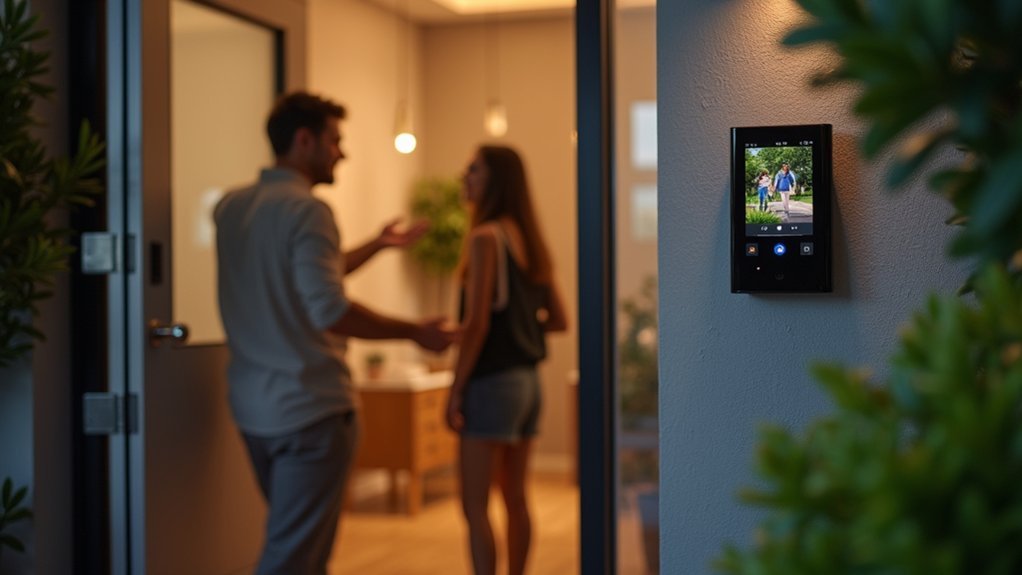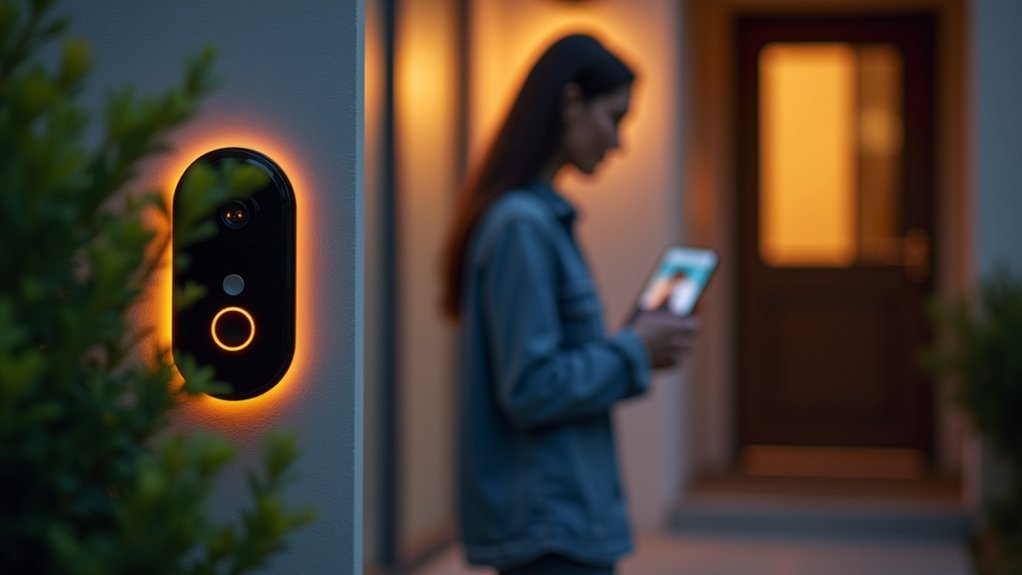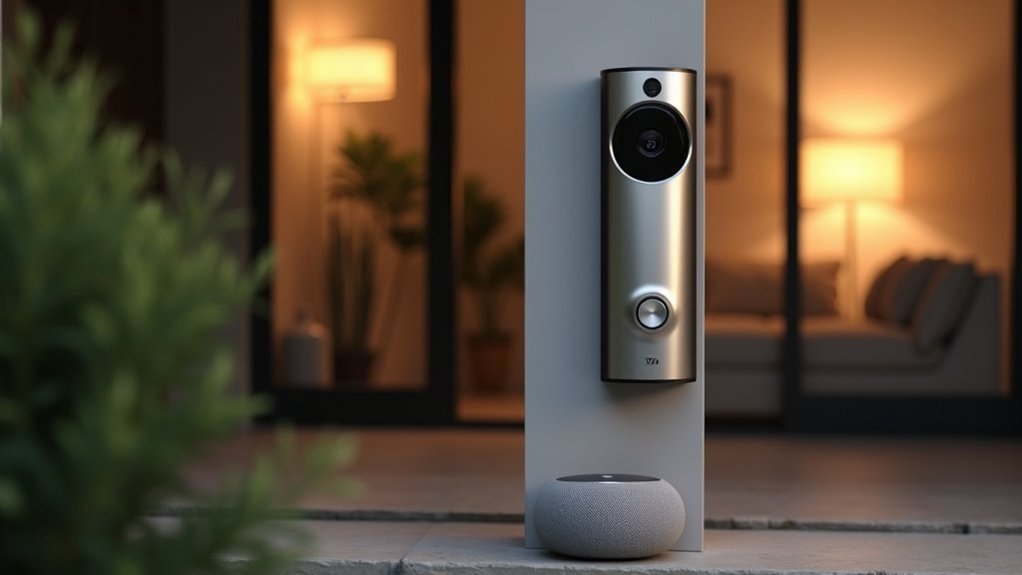Voice assistants transform home doorbell systems by enabling hands-free security management through simple commands. You’ll enjoy seamless integration with existing smart home ecosystems, creating automated routines that enhance protection. Two-way communication lets you screen visitors remotely, while accessibility features benefit everyone, including those with mobility impairments. With AI-powered analysis reducing false alarms and 5G enabling instant responses, your doorbell becomes more than just an entry alert—it becomes your all-encompassing security command center.
Hands-Free Security Management for Modern Homeowners

As homeowners increasingly prioritize both convenience and protection, voice-integrated security systems have transformed traditional home monitoring.
You’ll experience unprecedented control through simple voice commands that arm or disarm your security system without physical interaction.
When visitors approach, AI-powered sensors detect their presence and send instant notifications to your devices.
You can communicate directly through two-way audio while viewing clear footage—even in darkness thanks to night vision capabilities.
This hands-free approach offers practical benefits beyond convenience.
You’ll manage your home security from anywhere using your smartphone, customize privacy settings to reduce unnecessary alerts, and benefit from reduced false alarms through advanced human detection algorithms.
The combination of voice commands and proactive monitoring provides situational awareness before visitors even ring the doorbell.
The SwannBuddy4K’s innovative SwannShield AI can have complete conversations with guests when you’re unavailable, adding an extra layer of security without your intervention.
Seamless Integration With Existing Smart Home Ecosystems
Connecting your voice assistant with a smart doorbell marks the beginning of a truly unified home ecosystem. Your devices must share the same Wi-Fi network to communicate effectively, ensuring commands flow seamlessly between platforms.
Before purchasing, verify compatibility between your existing ecosystem—whether Amazon Alexa, Google Assistant, or Apple HomeKit—and your smart doorbell. This foresight prevents frustrating integration issues later.
Always check ecosystem compatibility before investing in new smart home devices to avoid integration headaches down the road.
The real magic happens when you create automated routines. When someone rings your doorbell, lights can automatically illuminate, security cameras can activate, and notifications can appear on your devices—all without lifting a finger. According to FBI data, homes without these advanced security measures are three times more likely to be targeted by burglars.
With over 70% of smart home users embracing these automation routines, you’ll join the majority who’ve discovered how centralized control transforms everyday security into an intuitive experience.
Enhanced Two-Way Communication Capabilities

Modern smart doorbells transform visitor interactions through sophisticated two-way communication features that extend well beyond traditional doorbell functionality. You’ll experience real-time conversations with visitors without opening your door, enhancing both convenience and security.
| Feature | Benefit | Application |
|---|---|---|
| Two-way audio | Instant verification | Screen visitors remotely |
| Mobile app integration | Anywhere access | Answer door while away |
| Pre-recorded messages | Convenience | Automate common responses |
| Voice deterrence | Security | Warn potential intruders |
| AI voice assistants | Automation | Handle routine interactions |
Whether you’re at home or across town, you can communicate clearly with delivery personnel, friends, or unexpected visitors. This capability not only streamlines daily interactions but also serves as a powerful security tool, allowing you to project presence even when you’re away. The Swann EVO Wireless Video Doorbell features the award-winning SwannShield AI Voice Assistant that talks with visitors naturally when you’re unavailable or uncomfortable answering the door.
Accessibility Features That Benefit Everyone
While two-way communication creates a seamless experience for many users, the integration of accessibility features in voice assistants and smart doorbells has transformed these technologies into truly inclusive tools.
You’ll find these systems particularly valuable if you have mobility impairments, as they enable completely hands-free control of your home’s entry points.
Screen reader integration benefits those with visual impairments, while customizable voice recognition adapts to your unique speech patterns—including support for speech impairments.
You’re no longer required to physically interact with devices, creating a more intuitive interface for everyone.
Beyond accessibility, these features simplify your smart home management by providing a single control point for multiple devices.
The beauty of these innovations is that they improve everyone’s experience while removing barriers for those who need them most.
This technology particularly empowers the 13.7% of people with mobility disabilities affecting hands and arms, offering them newfound independence in home security management.
The Future of Voice-Powered Home Security

As we look toward the next decade, voice-powered home security stands at the threshold of unprecedented innovation.
By 2025, over 70% of devices will seamlessly integrate with each other, creating unified security ecosystems controlled through a single interface.
You’ll benefit from AI-powered analysis that automatically identifies threats and reduces false alarms. The integration of AI-based threat detection is becoming a standard feature in modern smart home security cameras.
With 5G and enhanced IoT infrastructure, your voice commands will trigger instant responses from your doorbell camera and security systems.
The market growth speaks volumes—voice assistants are projected to reach $33.74 billion by 2030, while the smart home security market continues its rapid expansion.
This convergence means you’ll soon enjoy proactive protection where your system anticipates needs rather than simply responding to commands.
Frequently Asked Questions
How Much Data Do Voice-Enabled Doorbell Systems Consume Monthly?
Your voice-enabled doorbell system’s monthly data usage varies widely: 2-10GB for battery models with event-based recording, 50-150GB for wired systems with 24/7 recording, depending on video quality and how often you check footage.
Can Voice Assistants Distinguish Between Actual Visitors and Package Deliveries?
Yes, your voice assistant can distinguish between visitors and deliveries, but it relies on the doorbell’s AI video analysis – not voice recognition – to identify and announce different visitor types through your smart speakers.
What Happens During Internet Outages With Voice-Integrated Doorbell Systems?
During internet outages, your voice-integrated doorbell loses cloud functions like remote access and AI features. You’ll still hear basic chimes, but voice commands won’t work. Keep physical keys handy as backup for essential security access.
How Secure Are Voice Commands Against Unauthorized Access Attempts?
Voice commands are highly vulnerable to unauthorized access. Your doorbell could be compromised through hidden audio commands, ultrasonic frequencies, or spoofed voices. Without two-factor authentication, attackers can easily bypass security and access your system.
Can Voice-Controlled Doorbells Work With Multiple Different Assistant Platforms Simultaneously?
Yes, many doorbell models work with multiple assistants simultaneously. You’ll find options compatible with both Alexa and Google Assistant, though you may experience limited functionality or need specific models for seamless cross-platform integration.
In Summary
You’re witnessing a revolution in home security. Voice assistants don’t just make your doorbell smarter—they transform how you protect your home. They’ll continue to evolve with better AI, more natural interactions, and stronger security features. As these technologies merge seamlessly into your daily life, you’ll wonder how you ever managed your home security without them.





Leave a Reply